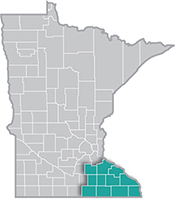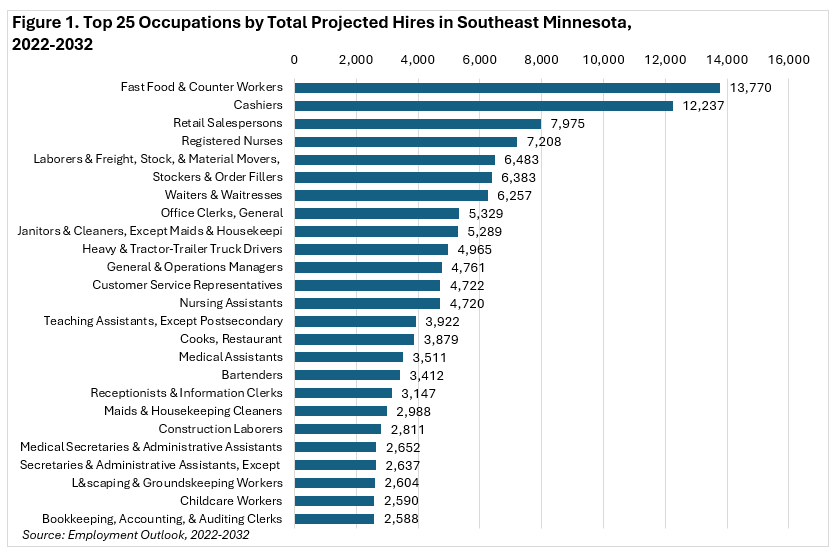 Southeast Minnesota is a health care and agricultural powerhouse. The region is home to the renowned Mayo Clinic and some of the world's most recognized food companies and brands.
Southeast Minnesota is a health care and agricultural powerhouse. The region is home to the renowned Mayo Clinic and some of the world's most recognized food companies and brands.
Advanced manufacturing is especially strong here, with machinery, chemicals, and electronics among the top products.
Want the freshest data delivered by email? Subscribe to our regional newsletters.
2/19/2025 2:22:10 PM
Amanda Blaschko
DEED's latest /deed/data/data-tools/employment-outlook/index.jspemployment projections for 2022-2032 provide insight into how jobs and industries are expected to change across Minnesota and our six planning regions. This analysis focuses on Southeast Minnesota's occupational projections, examining key trends in the region's labor market.
The 11-county Southeast Minnesota planning region is projected to add 12,280 new jobs by 2032, reflecting a 4.5% growth rate that closely aligns with the statewide increase of 4.6%. But beyond just new job creation, the region is also projected to experience about 134,600 workers potentially leaving the labor force and another 163,000 changing occupations over the decade. This creates a total hiring demand of nearly 310,000 positions over the decade, highlighting the importance of both job growth and replacement needs (Table 1).
| Table 1. Regional Employment Projections, 2022-2032 | |||||||
|---|---|---|---|---|---|---|---|
| Occupational Group | Southeast Minnesota | ||||||
| 2022 Estimate | 2032 Projection | 2022-2032 Percent Change | Total Job Growth Change | Labor Force Exit Openings | Transfer Openings | 2022-2032 Total Hires | |
| Total, All Occupations | 270,975 | 283,255 | +4.5% | +12,280 | +134,631 | +163,022 | +309,933 |
| Management | 17,837 | 19,081 | +7.0% | +1,244 | +5,891 | +8,289 | +15,424 |
| Business & Financial Operations | 10,528 | 11,161 | +6.0% | +633 | +3,369 | +5,199 | +9,201 |
| Computer & Mathematical | 4,255 | 4,727 | +11.1% | +472 | +970 | +1,652 | +3,094 |
| Architecture & Engineering | 3,696 | 4,045 | +9.4% | +349 | +1,100 | +1,420 | +2,869 |
| Life, Physical, & Social Science | 2,517 | 2,690 | +6.9% | +173 | +550 | +1,504 | +2,227 |
| Community & Social Service | 6,085 | 6,519 | +7.1% | +434 | +2,488 | +2,997 | +5,919 |
| Legal | 932 | 965 | +3.5% | +33 | +264 | +272 | +569 |
| Education, Training, & Library | 15,626 | 16,142 | +3.3% | +516 | +7,202 | +6,978 | +14,696 |
| Arts, Design, Entertainment & Media | 4,325 | 4,437 | +2.6% | +112 | +1,976 | +2,404 | +4,492 |
| Healthcare Practitioners & Technical | 32,610 | 35,639 | +9.3% | +3,029 | +10,264 | +7,637 | +20,930 |
| Healthcare Support | 15,423 | 16,902 | +9.6% | +1,479 | +10,950 | +11,887 | +24,316 |
| Protective Service | 4,251 | 4,332 | +1.9% | +81 | +2,086 | +2,407 | +4,574 |
| Food Preparation & Serving Related | 20,490 | 21,366 | +4.3% | +876 | +17,736 | +21,649 | +40,261 |
| Building, Grounds Cleaning & Maint. | 8,466 | 8,860 | +4.7% | +394 | +5,488 | +6,116 | +11,998 |
| Personal Care & Service | 6,960 | 7,449 | +7.0% | +489 | +4,689 | +7,301 | +12,479 |
| Sales & Related | 21,072 | 20,838 | -1.1% | -234 | +13,340 | +15,722 | +28,828 |
| Office & Administrative Support | 29,750 | 28,886 | -2.9% | -864 | +15,762 | +17,463 | +32,361 |
| Farming, Fishing, & Forestry | 2,022 | 2,060 | +1.9% | +38 | +1,144 | +1,831 | +3,013 |
| Construction & Extraction | 11,207 | 11,926 | +6.4% | +719 | +3,973 | +5,719 | +10,411 |
| Installation, Maintenance, & Repair | 9,366 | 9,983 | +6.6% | +617 | +3,748 | +4,649 | +9,014 |
| Production | 23,228 | 23,595 | +1.6% | +367 | +10,382 | +14,776 | +25,525 |
| Transportation & Material Moving | 20,329 | 21,652 | +6.5% | +1,323 | +11,259 | +15,150 | +27,732 |
| Source: DEED 2022-2032 Employment Outlook | |||||||
There are four occupational groups that are projected to have over a 9% increase in new jobs from 2022 to 2032, with Computer & Mathematical leading the way (+11.1%; +472 jobs). Healthcare continues to be a major driver of job growth, with Healthcare Support growing by 9.6% (+1,479 jobs) and Healthcare Practitioners & Technical increasing by 9.3% (+3,029 jobs). The region's technical workforce is also expected to expand rapidly, with Architecture & Engineering jobs projected to grow by 9.4% (+349 jobs).
Looking deeper at these high-growth occupational groups, the Computer & Mathematical occupational group shows strong wage potential and growing demand. Data Scientists lead with 35% growth (+14 jobs), followed by Information Security Analysts (+24.4%; +20 jobs), and Software Developers (+23.5%; 335 jobs), all offering median wages above $60 per hour. In healthcare, the strongest growth appears in advanced practice roles, with Nurse Practitioners projected to grow by 57.2% (+736 jobs), Physician Assistants by 30.5% (+362 jobs), and Occupational Therapy Assistants by 24% (+12 jobs). The Architecture & Engineering occupational group shows promising growth in specific occupations such as Mechanical Engineers (+16%; +62 jobs), Industrial Engineers (+15.1%; +189 jobs), and Bioengineers (+14.3%; +2 jobs). Median annual wages for these occupations range from $60,000 to more than $130,000.
While job growth tells part of the story, the full picture of workforce demand emerges when we look at total hiring needs. Over the next decade, employers will need workers not just for new positions, but also to replace those who retire (labor force exits) and those who change careers (occupational transfers). Figure 1 illustrates the top 25 occupations where this combined demand, what we call total hires, will be greatest from 2022 to 2032. These numbers give us a more complete view of occupational opportunities in Southeast Minnesota.

Entry-level positions make up the majority of occupations with the highest projected total hires through 2032. Of these top 25, 19 occupations would typically be considered entry level positions, requiring a high school diploma or equivalent. These roles often require short-term to moderate-term on-the-job training, making them accessible starting points for workers entering the labor force or changing careers. Annual median wages for these entry-level positions range from $23,841 for Waiters & Waitresses to $50,301 for Construction Laborers. Among the occupations requiring more education, Registered Nurses (Associate's Degree) lead with median annual wages of $100,239, followed by General & Operations Managers (Bachelor's Degree) at $83,723. Several occupations require additional education, training, or licenses, including Heavy & Tractor-Trailer Truck Drivers ($60,838), Medical Assistants ($48,598), and Bookkeeping, Accounting, & Auditing Clerks ($49,912).
This mix of educational requirements and varying wage levels provides diverse opportunities for job seekers across Southeast Minnesota, particularly those beginning their career journey. Overall, Southeast Minnesota's employment projections show promising opportunities across various skill levels. While healthcare, technology, and engineering show strong growth rates, the largest volume of total hires will be in positions accessible to workers with a high school diploma, suggesting opportunities for workers at all career stages.
Contact Amanda Blaschko at amanda.blaschko@state.mn.us.